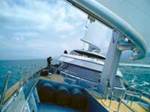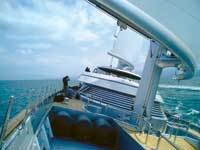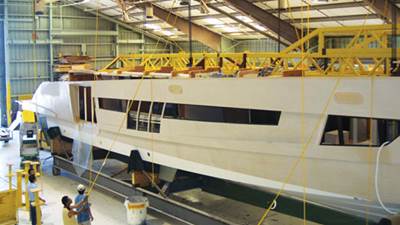FEA facilitates custom megayacht design
Modeling software and design ingenuity meet vibration challenges in ocean-going luxury yacht.Ìę
Engineering Challenge:
A custom yacht buyerâs request for large, open interiors compromises structural stiffness in the vesselâs initial design, resulting in racking motion during vibration load simulations.
Design Solution:
Finite element analysis shows that the racking problem can be solved with the addition of a composite âracking frameâ that stiffens the hull structure without sacrificing living space.Ìę
The lucky individuals who have the resources to afford a megayacht â a custom, crewed vessel, typically in excess of 30m/100 ft in length and costing millions â have come to expect not only a seaworthy vessel, but also luxurious interior spaces. Large, open yacht interiors are a decoratorâs dream, but they can be a naval architectâs nightmare because they complicate the structural design.
One notable example is Mr. Terrible, launched in 2007 and outfitted with expansive and sumptuous interiors that added extra weight and posed major composite design challenges for Delta Marine Industries (Seattle, Wash.).
Delta Marine project engineer Chad Caron, a naval architect and a professional engineer, credits composite materials with enabling greater design flexibility. âWe can tailor them to a high degree, as we did for Mr. Terrible.â But he points out that, in this case, success might have been elusive without the service of finite element analysis (FEA) software.
Modeling a monster megayacht
Although Delta got its start using composites to build commercial fishing vessels to withstand harsh conditions in Alaska, it made the transition to its current specialty of large luxury motoryachts in the 1980s. Today, says Caron, âa client comes to us with a concept. Our job is to realize and clarify that concept with a purely custom design.â
The first step is to establish how the vessel will be used â for example, long cruises require additional fuel storage, while visits to small ports with shallow water necessitate a shallow draft. For Mr. Terrible, notes Caron, the client wanted a glamorous showpiece that could travel at relatively high speed. For that reason, Delta Marine targeted a semidisplacement hull â one shaped to lift slightly out of the water and over its bow wave when under power. This decreases the hullâs wetted length and, thus, reduces drag, resulting in greater speed than a simple displacement hull, explains Caron. Delta Marine maintains several semidisplacement hull mold shapes that can be modified slightly for each project â for Mr. Terrible, total length was 47m/154.2 ft and beam was 8.8m/28.9 ft, with a 2.2m/7.2-ft draft. After the general hull configuration was defined, Caron began his structural design by determining the loads the composite vessel would have to resist. âEssentially, you start by envisioning the boat as one large beam,â he explains. Determined with an assumed weight estimate, first-order bending moments â sagging, when supported at ends by two waves, or hogging, when riding on one wave, amidships â can be on the order of 8,135 kN-m (6,000 kip-ft). Added to that are acceleration loads â heave and surge, roll and pitch â caused by wave action. At the next level, he calculated wave slamming and pressure loads (caused by standing water on the deck, for example). Finally, says Caron, he considered âstress intensifiers,â such as planned hull penetrations that accommodate the bow thrusters and other equipment. In line with the clientâs request for speed, the hull had be designed to resist these loads at minimal weight.
Given these performance requirements, the boatâs general composite structure was developed based on Delta Marineâs in-house design parameters, which Caron says have been verified by rigorous in-house testing and through property testing by material suppliers. Rather than rely on traditional scantlings (structural design data) provided by major classification societies, such as Lloydâs Register (London, U.K.) or the American Bureau of Shipping (ABS, Houston, Texas), Delta uses its own proprietary design strategies that Caron says are more rigorous.
âWe design beyond the rules provided by the classification societies,â he explains. âWe do use those general rules as a cross-check for our customers if they wish to be âclassed.ââ (For a fee, a yacht buyer can have the vessel inspected, classed and registered by a society, as a means of documenting seaworthiness for insurance purposes. Mr. Terrible is now registered by ABS.) Knowing that the interior spaces on this project would be substantial, Delta Marine selected carbon fiber reinforcement for the majority of the hull and deck structural composites to maximize performance and, in the case of the decks, stiffness, with minimal weight.
As the design progressed, the primary shapes and dimensions of the vesselâs components were determined in Rhinoceros 3D software from McNeel North America (Seattle, Wash.). For Mr. Terrible, the hull below the waterline was designed as a solid laminate, for better resistance to impact damage, while cored sandwich structure was employed above the waterline and in three horizontal decks: the flybridge, the boat deck (with the main living area) and the lowermost weather deck. It was here, where the deck layout had to accommodate unusually expansive interior spaces, that designing the structural support elements and engineering the load paths between the decks became very complex.
âTraditional design methods, like handbook formulae or rules of thumb, are not adequate to achieve an optimized structural assessment for a vessel of this size and complexity,â notes Caron. âWe had to perform finite element analysis on a global basis to adequately develop the integrated structure.â Delta Marine employed ANSYS Mechanical software from ANSYS Inc. (Canonsburg, Pa.) because of its ability to model layered shells and solids, allow property specification on a ply-by-ply basis, and predict laminate failure modes. The Rhinoceros solid model was exported to a neutral file format and then imported into ANSYS Mechanical to provide the geometry for the FEA model mesh. Caron built the model, using the shell elements to represent the laminate stacks of the vesselâs side shells and decks. Solid elements represented support components, such as longitudinal girders and transverse beams in the hull.
FE analysis reveals ârackingâ
The software not only helped to optimize the vesselâs structure via laminate behavior prediction, but also was able to model response to vibration frequencies by performing vibration modal analyses. Vibrations, which result from wave impact as well as the vesselâs engines, must be minimized for customer comfort, so predicting them is an important part of the overall analysis, says Caron. He used Delta Marineâs in-house data to estimate interior weights, using per-square-foot targets for various materials. These âoutfitâ weights, together with the structural and mechanical weight components (i.e., engine, drives and fuel), coupled with the hydrodynamic loads imposed by the water, determined the yachtâs overall weight estimate and enabled calculation of vibration frequencies and mode shapes during operation.
According to Caron, the FEA modeling results revealed that the yacht, as designed, would experience a ârackingâ vibration mode. That is, the boatâs superstructure and the lower decks moved back and forth horizontally in opposite directions. âThink of a large cruise ship, with hundreds of cabins,â Caron illustrates. âIt never experiences racking problems because the numerous transverse cabin walls make the ship stiffer,â notes Caron. By contrast, the combination of Mr. Terribleâs open interior, with its very few transverse bulkheads, and the weight of the luxurious trimmings throughout compromised the structural stiffness. âEssentially, the vessel was behaving like a deck of cards, with the cards sliding past each other and decoupling structurally.â A fix was needed to minimize the racking, yet maintain the customerâs primary design brief.
Without the option of adding interior walls, Delta instead designed and built a composite âracking frame,â an open rectangular framework that vertically spans all three superstructure decks and ties them together (see computer rendering, above). The frame design specified multiple plies of biaxial (±45°, 0/90°) and unidirectional fabrics, to resist shear forces caused by the vesselâs vibration. The 4.9m high by 7m wide by 178-mm deep (16.1-ft by 23-ft by 7-inch)ÌęÌę frame, with a laminate thickness of about 25 mm/1 inch, was situated amidships above a transverse bulkhead below the weather deck and taped (wet laminated) to structural mullions on each side of the vessel.Ìę Functionally, the frame not only ties the vessel together structurally, but its composites also act to damp the vibration and minimize frequency transmission between living areas.
The frame was fabricated by hand layup of dry carbon and glass fabrics supplied by Vectorply Corp. (Phenix City, Ala.) and OCV Technical Fabrics (Toledo, Ohio). The layup was vacuum infused using a room-temperature-cure vinyl ester resin from Reichhold Inc. (Triangle Research Park, N.C.).Ìę
Mr. Terribleâs final hull design included a solid, uncored monolithic laminate below the waterline, made up of approximately 18 plies of stitchbonded glass fabric, with 30-plus plies making up the keel. Above the water, the cored sandwich construction featured 50-mm/2-inch thick balsa core from Alcan Baltek (Northvale, N.J.) faced with hybrid fiberglass and carbon fiber skins, made up of 14 plies of stitchbonded biaxial fabric that incorporates continuous fiber mat on the back side, supplied by Vectorply and OCV. Decks were made in the same manner, but with thinner skins. The hull and deck builds were accomplished via wet layup and vacuum infusion, using the same Reichhold resin.
Tailored design with FEA
Caron says Deltaâs design process enabled him to determine exactly how loads are distributed through the complex structure, so that the structural elements could be tailored to provide strength and stiffness where needed. âWe put walls and partitions where the client wanted, while keeping weight to a minimum,â Caron sums up. But he is careful to point out that âthis is a tailored solution that would not have been possible without modeling,â adding that FEA software âwas instrumental for predicting the laminate behavior under load, as well as helping to define the frameâs design.â
Dipankar Choudhury, VP of product strategy and planning at ANSYS, concludes, âModeling software makes it possible for a boatyard to create yachts with interiors based on aesthetics, and not just structural considerations.â
Related Content
Composite Integration presents webinar on liquid resin infusion
On July 30, 2025, company experts will discuss the role of LRI in delivering scalable, OOA composite production for the aerospace sector.
Read MoreCOMPINNOV TP2 project promotes use of thermoplastics in aerospace
Completed in 2023, COMPINNOV TP2 explored thermoplastic composites, enhancing the understanding between prepregs and production methods to foster the potential for French aerospace innovation.
Read MoreFlyber launches U.K. composites manufacturing site for advanced mobility applications
The startup’s design automation and composite material layup and curing technologies target lightweighting for aerospace, UAVs, eVTOL and high-performance mobility platforms.
Read MoreInduction heating system enables OOA composites processing
JEC World 2025: Roctool focuses attendees’ attention on the light induction tooling (LIT) system targeting efficiency, sustainability and performance.
Read MoreRead Next
Megayacht Composite Masts Get Smart
Freestanding square rigging is fully instrumented for structural health monitoring while under sail.
Read MoreCompetitive to the core
ÌęThis new superyacht combines luxury innovations with energy-efficient construction, enabled by a new marine-grade balsa core.
Read MoreUltrasonic welding for in-space manufacturing of CFRTP
Agile Ultrasonics and NASA trial robotic-compatible carbon fiber-reinforced thermoplastic ultrasonic welding technology for space structures.
Read More












